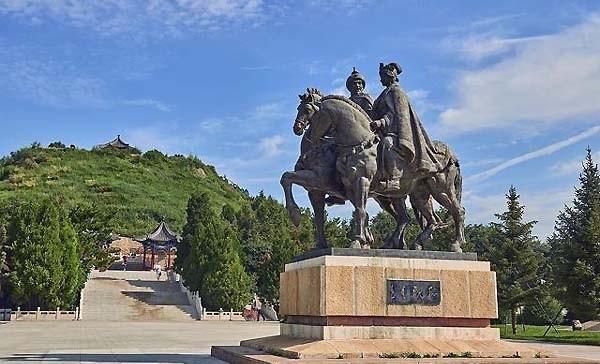At the top of the Aozuka is where Shōgun sleeps forever. The breeze blows, and the mountains there are always grassy.

Wang Zhaojun and pro bronze statue
In October 1963, Dong Biwu, then vice president of the state, came to Inner Mongolia to inspect, and after visiting the tomb of Zhaojun, he inscribed a poem "Gurudwara Zhaojun's Tomb": "Zhaojun has his own thousand autumns, and Hu Hanhe and his relatives have seen high." The lyricists each express their chests, and the dance text is always futile. A few words summed up the story of Zhaojun's departure during the Western Han Dynasty. This poem, now stoned, has been stoned and placed at the head of the Yongdao Road in the memorial cemetery of Wang Zhaojun.
We drove more than ten miles south from Hohhot to the Zhaojun Museum to see. According to the statistics of the Hohhot Tourism Department, more than 80% of foreign tourists will come here to visit. Only to see the commemorative cemetery imposing, solemn, on both sides of the gate two unique shapes of the national characteristics of the memorial exhibition hall, in the shape of an earth yellow pyramid, highlighting the vicissitudes and thickness of history, people can't help but think of a passage by the famous historian Mr. Zhai Bozan: "At the foot of daqing mountain, there is only one monument that will never be abandoned, that is, the tomb of Zhaojun known as qingzuka." Because in the hearts of the people of Inner Mongolia, Wang Zhaojun is no longer a figure, but a symbol, a symbol of national unity. The tomb of Zhaojun is also not a tomb, but a historical memorial tower of national friendship. ”
Zhaojun Tomb, also known as "Qingzuka", is the burial place of Zhaojun, the Ming Concubine of the Han Dynasty in historical records and folklore, which was built in the Western Han Dynasty and was built by han dynasty artificial soil rammed. The tomb is like a bucket, 33 meters high, has a history of more than 2,000 years, and is one of the best-preserved large Han tombs in mainland China. "Aozuka" comes from Du Shi's commentary: "The grass in the north is white, but the grass on the tomb of Zhaojun is as green as a green, so it is called Aozuka." "Folklore says that every late autumn, when the four wild grasses and trees withered and yellowed, only the tomb of Zhaojun was tender yellow and green, and the grass was green. Therefore, poets throughout the ages often use verses such as "Whose tomb is young" and "There is more grass on the present tomb".
Throughout the ages, it is said that there are more than 700 poems that have been handed down to reflect Wang Zhaojun; there are nearly 40 related novels and folk tales. Among the authors are Li Bai, Du Fu, Bai Juyi, Wang Anshi and other poets. Two outstanding playwrights in modern times, Guo Moruo and Cao Yu, have both written the script of "Wang Zhaojun". In 1978, Cao Yu said in a dedication after completing the creation of the script of "Wang Zhaojun": "The beloved Premier Zhou gave me this task before I was born. I understood premier Zhou's meaning to use this theme to praise the unity of the various ethnic groups on the mainland and the cultural exchanges between ethnic groups. I dedicate this script to the thirtieth anniversary of the National Day of the motherland and use it to commemorate our beloved Premier Zhou. Today, these far-reaching cultural imprints and beautiful historical facts are displayed in the Zhaojun Cultural Communication Hall of the Zhaojun Museum.
Many tourists take photos against the backdrop of the bronze statues of Wang Zhaojun and Hu Han evil dan who are close to each other. Nearly 4 meters high and weighing 5 tons, the bronze statue was carved by Mr. Pan He of the Guangzhou Academy of Fine Arts during the 40th anniversary of the founding of the Inner Mongolia Autonomous Region in 1987. The two bronze horses, one looking back and whispering, listened with one ear, reproducing the harmonious family affection of the han and Mongolian peoples. On the slope on the north side of the statue are two antique stele pavilions, in which stand the stele of "Tomb of Wang Zhaojun" written in Chinese and Mongolian. Further up, at the top of the Aozuka, is where Shōgun sleeps permanently. The breeze blows, and the mountains there are always grassy. (Gu Dinghai)